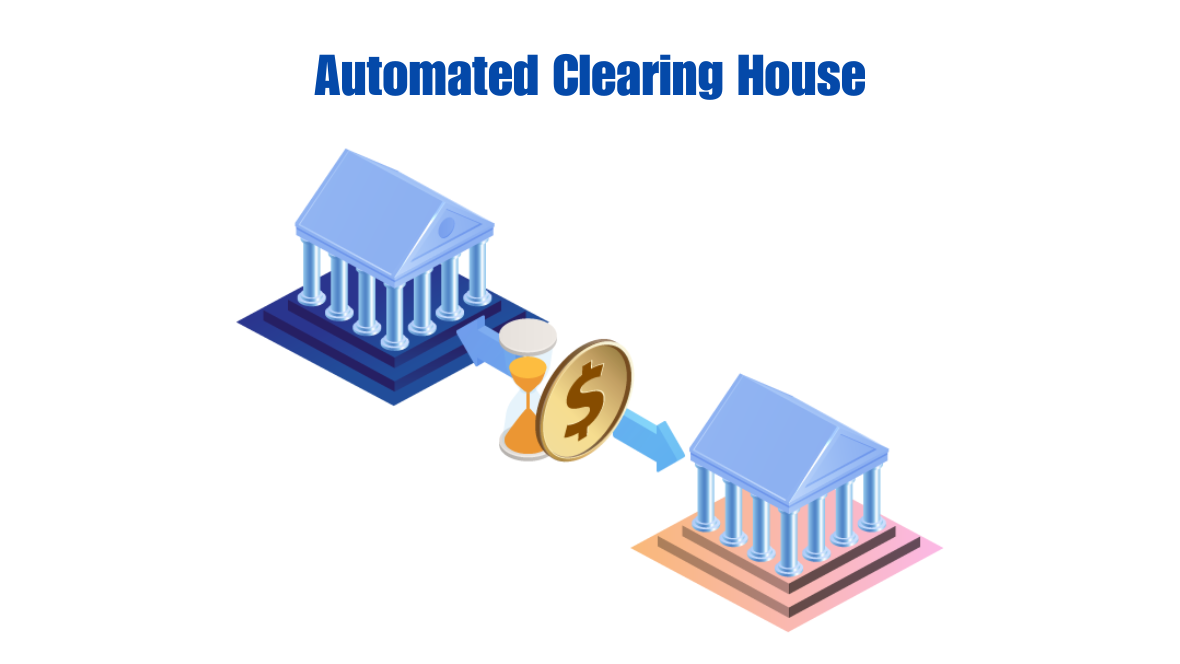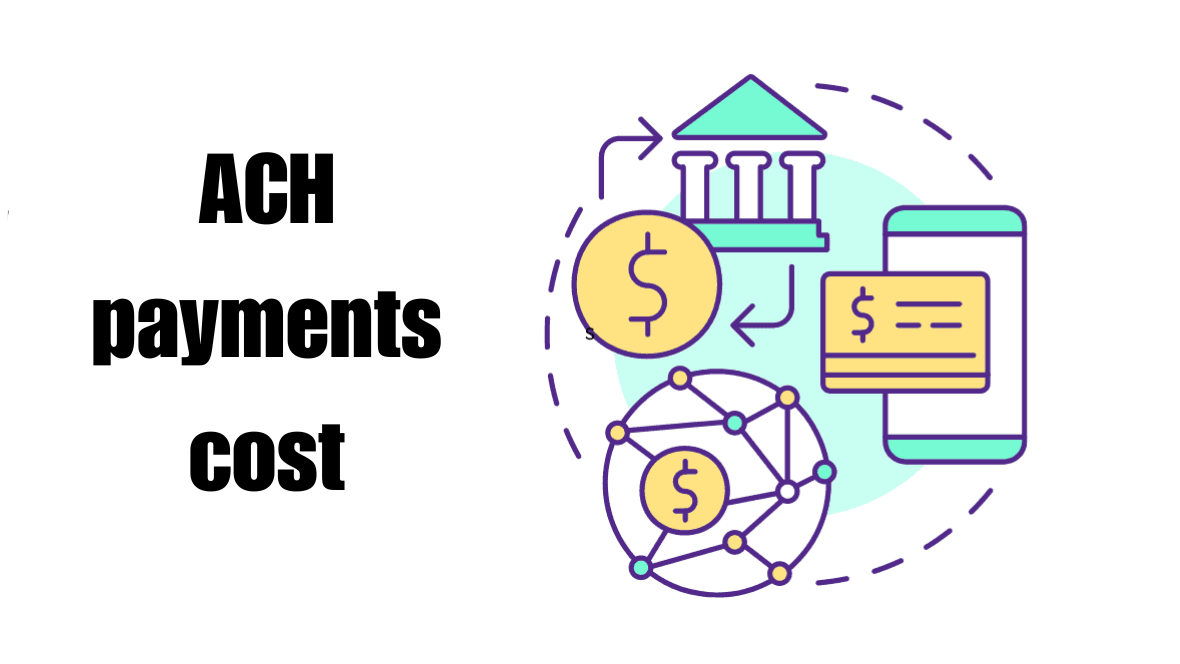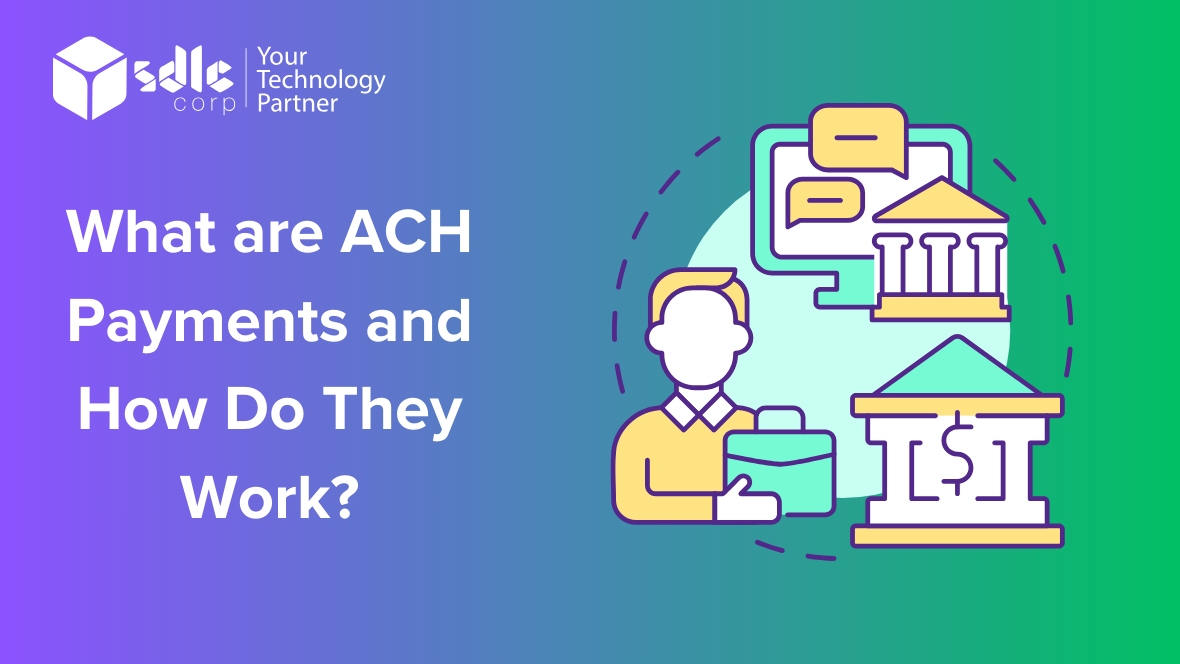What are ACH Payments and How Do They Work?
ACH (Automated Clearing House) transactions are electronic transfers of funds between banks and financial institutions in the United States, facilitating various payment types such as direct deposits, bill payments, and business-to-business transactions. Governed by the National Automated Clearing House Association (NACHA), ACH transfers are renowned for their efficiency, security, and cost-effectiveness. Initiation of an ACH transfer involves authorization by the sender, who provides bank account information and recipient details. Subsequently, the sender’s financial institution submits the transaction to the ACH network, initiating processing by the recipient’s bank. Once verified, funds are debited from the sender’s account and credited to the recipient’s, facilitated by the ACH network’s settlement process. Confirmation of the successful transfer is received by both parties, with records maintained by banks for accounting and reconciliation. ACH transactions offer efficiency, security, and cost-effectiveness, making them a preferred choice for businesses and individuals seeking seamless fund transfers.
How Its Work?
ACH (Automated Clearing House) transactions are electronic transfers of funds between bank accounts. They’re commonly used for various financial transactions, such as direct deposits, bill payments, and business-to-business payments.
1. Initiation: The process begins when a sender initiates an ACH transaction. This could be an individual, a business, or a financial institution. They provide authorization for the transfer, specifying the amount to be transferred, the recipient’s bank account details, and other relevant information.
2. Submission to ACH Network: Once initiated, the transaction details are submitted to the ACH network. The ACH network is a highly regulated and secure system managed by the National Automated Clearing House Association (NACHA) in the United States. It acts as a central hub for processing ACH transactions.
3. Routing: The ACH network routes the transaction details to the recipient’s bank, which is known as the receiving depository financial institution (RDFI). The RDFI verifies the transaction details and ensures that the recipient’s account is valid and able to receive the funds.
4. Processing: Upon verification, the funds are debited from the sender’s account and credited to the recipient’s account. This process typically takes a few business days to complete, although same-day ACH processing is also available for certain transactions.
5. Notification: Once the transaction is processed, both the sender and the recipient may receive notifications confirming the transfer. These notifications can be in the form of email alerts, bank statements, or messages through banking apps.
6. Settlement: Finally, the transaction is settled between the sender’s and recipient’s banks. Settlement involves the actual transfer of funds between the banks’ accounts to complete the transaction.
ACH transactions offer several benefits, including:
– Cost-Effectiveness: ACH transactions are often cheaper than other forms of payment, such as wire transfers or paper checks, making them an attractive option for businesses looking to save on transaction fees.
– Efficiency: ACH transactions are processed electronically, which reduces the time and effort required for manual handling and processing of paper-based transactions.
– Convenience: ACH transactions can be scheduled in advance, allowing for automated recurring payments such as payroll deposits, bill payments, and subscription renewals.
In the context of account payable (AP) processes, businesses can leverage ACH transactions to streamline their payment workflows. By integrating ACH payment capabilities into their AP systems, businesses can automate the payment process, improve cash flow management, and reduce the risk of errors associated with manual payment processing. Additionally, ACH transactions offer greater security compared to paper checks, as they eliminate the risk of check fraud and unauthorized alterations. Overall, ACH transactions play a crucial role in modernizing and optimizing accounts payable processes for businesses of all sizes.

What is ACH?
Automated Clearing House (ACH) is a widely used electronic network for financial transactions in the United States. It facilitates various types of payments, including direct deposits, payroll, consumer bills, tax refunds, and many more. Essentially, ACH works as a secure system that enables the transfer of funds between bank accounts without the need for paper checks or wire transfers.
Here’s how it works:
When a sender initiates an ACH transaction, such as paying bills online or receiving a direct deposit paycheck, the transaction details are entered into the ACH network. These details typically include the sender’s bank account information, the recipient’s account information, the transaction amount, and any relevant payment instructions. The ACH network then processes these transactions in batches, sorting and routing them to the appropriate banks involved. Once received by the recipient’s bank, the funds are deposited into the designated account. The entire process is automated, efficient, and cost-effective compared to traditional paper-based methods. Additionally, ACH transactions are governed by strict security protocols to ensure the integrity and safety of the financial data being transferred. Overall, ACH plays a crucial role in enabling seamless electronic payments, benefiting businesses, consumers, and financial institutions alike.
What are ACH Payments?
ACH (Automated Clearing House) payments are a fundamental component of the modern financial system, facilitating the electronic transfer of funds between bank accounts in the United States. The process begins when an originator, such as a business or individual, initiates a payment instruction through their bank or a third-party payment processor. This instruction includes the recipient’s bank routing number, account number, and the amount to be transferred. Once the payment is authorized, the originator’s bank sends the transaction details to the ACH network, a nationwide electronic payment system managed by the National Automated Clearing House Association (NACHA).
The ACH network acts as a central hub where payment instructions are sorted, processed, and settled between participating financial institutions. Upon receiving the instruction, the recipient’s bank credits the designated account with the funds. The entire process typically takes one to two business days to complete, although same-day ACH services are also available for faster transactions.
One of the key advantages of ACH payments is their efficiency and cost-effectiveness compared to traditional paper-based methods like checks. By leveraging electronic processing, ACH payments eliminate the need for physical checks to be printed, mailed, and manually deposited, reducing administrative overhead and the risk of errors or delays. Additionally, ACH payments are highly secure, utilizing encryption and authentication measures to safeguard sensitive financial information.
ACH payments are widely used for various purposes, including payroll direct deposits, bill payments, business-to-business transactions, and recurring payments like subscription services. They offer businesses and consumers a convenient, reliable, and scalable means of transferring funds electronically, contributing to the seamless functioning of the modern economy.
"Understanding ACH Transactions: Definition and Mechanisms"
What is the Difference between AHC Payments and Transfers?
Automated Clearing House (ACH) payments and transfers are both methods used for moving money electronically, but they serve different purposes and operate in distinct ways. ACH payments refer to transactions where funds are transferred between accounts using the ACH network, which is a secure electronic network managed by the National Automated Clearing House Association (NACHA). These payments are typically used for direct deposits, bill payments, and other recurring transactions. ACH transfers, on the other hand, involve moving money between accounts held by the same person or organization, often for purposes such as transferring funds between checking and savings accounts or making one-time payments to individuals or businesses.
The key difference between ACH payments and transfers lies in their direction and purpose. ACH payments involve transactions between different parties, such as an employer depositing wages into an employee’s account or a consumer paying a bill online. These transactions often involve the exchange of money for goods or services and may occur regularly on a scheduled basis.
ACH transfers, however, typically involve moving funds within the control of the same individual or organization, such as transferring money from a personal checking account to a savings account or sending funds to a friend or family member.
Additionally, ACH payments and transfers may differ in terms of processing time and cost. ACH payments often take several business days to clear, as they may require authorization and verification from multiple parties. In contrast, ACH transfers between accounts held by the same person or organization may be processed more quickly, sometimes within the same business day. Moreover, while ACH payments may incur fees for certain types of transactions, such as expedited processing or international transfers, ACH transfers between accounts typically do not involve additional charges beyond any fees imposed by the financial institutions involved.
Overall, while both ACH payments and transfers facilitate the electronic movement of funds, they serve different purposes and involve distinct processes. ACH payments are used for transactions between different parties, such as direct deposits and bill payments, while ACH transfers involve moving money within the control of the same individual or organization, such as transferring funds between accounts or sending money to friends and family. Understanding the differences between these two methods can help individuals and businesses effectively manage their finances and make informed decisions about how to best utilize electronic payment services.
What are the Types of ACH Payments?
Automated Clearing House (ACH) payments are electronic transfers of funds between bank accounts, allowing businesses and individuals to move money securely and efficiently. ACH payments work by leveraging a network that connects financial institutions to facilitate transactions. When a payment is initiated, the sender provides the bank with instructions, including the recipient’s account details and the amount to be transferred. The sender’s bank then forwards this information to the ACH network, which routes the transaction to the recipient’s bank. Once received, the recipient’s bank credits the funds to their account.
There are several types of ACH payments, each serving different purposes.
1. Direct Deposit: This type of ACH payment is commonly used for payroll, employee expense reimbursement, pension, and government benefit payments. Employers or payers initiate direct deposits to transfer funds directly into the recipient’s bank accounts.
2. Direct Payment: Also known as ACH debit transfers, direct payments allow businesses or individuals to initiate payments from their bank accounts to pay bills, mortgages, loans, or subscription services. This method is often used for recurring payments.
3. Electronic Checks (e-Checks): ACH payments can also be used to create electronic checks, which function similarly to paper checks but are processed electronically. Electronic checks are initiated by the recipient to collect funds from the payer’s bank account.
4. Business-to-Business (B2B) Payments: ACH payments facilitate transactions between businesses, enabling them to make payments to vendors, suppliers, and partners. B2B payments are often used for large transactions and typically involve higher dollar amounts compared to consumer transactions.
5. Person-to-Person (P2P) Payments: With the rise of mobile payment apps and online banking platforms, ACH has become increasingly popular for P2P payments. Individuals can use ACH transfers to send money to friends, family, or acquaintances directly from their bank accounts.
Overall, ACH payments offer a versatile and reliable method for transferring funds electronically, providing businesses and individuals with a convenient alternative to traditional paper-based transactions.
What are the types of ACH transfers?
1. Direct Deposit:
– Description: Direct deposit is a common type of ACH transfer where funds are electronically deposited directly into a recipient’s bank account. It is widely used for payroll purposes, government benefits, tax refunds, and vendor payments.
– Process: Employers or organizations initiate direct deposit by submitting payment instructions to their bank, which then sends the funds through the ACH network to the recipient’s bank account.
– Timing: Direct deposits typically take 1-2 business days to process, but the exact timing may vary depending on the sender’s and recipient’s banks.
2. Direct Payment:
– Description: Direct payment, also known as ACH debit, allows businesses or organizations to withdraw funds directly from a customer’s bank account to pay bills, subscriptions, or loans.
– Process: The business or organization obtains authorization from the customer to initiate ACH debits. They then submit payment instructions through the ACH network, and the funds are transferred from the customer’s bank account to the recipient’s account.
– Timing: Direct payments may take 1-3 business days to process, depending on the banks involved and the timing of the transaction.
3. Recurring Payments:
– Description: Recurring payments are a type of direct payment where funds are transferred on a regular schedule, such as weekly, bi-weekly, monthly, or annually. They are commonly used for subscription services, loan payments, and utility bills.
– Process: Customers provide authorization for recurring payments, and the payment amount is deducted automatically from their bank account according to the specified schedule.
– Timing: Recurring payments follow the same processing timeline as direct payments, typically taking 1-3 business days to complete.
4. Person-to-Person (P2P) Transfers:
– Description: P2P transfers enable individuals to send money electronically from their bank account to another person’s bank account. They are often used for splitting bills, repaying debts, or sending gifts.
– Process: Users initiate P2P transfers through online banking portals, mobile banking apps, or third-party payment platforms. They provide the recipient’s bank account details and the amount to be transferred.
– Timing: P2P transfers can vary in processing time, with some instant transfer options available, while others may take 1-3 business days to complete.
5. Business-to-Business (B2B) Payments:
– Description: B2B payments involve the transfer of funds between businesses for goods or services rendered. These transactions may include payments to suppliers, vendors, or contractors.
– Process: Businesses initiate B2B payments by providing payment instructions to their bank or through specialized B2B payment platforms. The funds are transferred electronically through the ACH network to the recipient’s bank account.
– Timing: B2B payments typically take 1-3 business days to process, depending on factors such as the banks involved and the timing of the transaction.
6. International ACH Transactions (IAT):
– Description: IAT allows for ACH transfers between bank accounts in different countries. It is used for cross-border payments, such as remittances, international bill payments, and business transactions.
– Process: IAT transactions require additional information, such as the recipient’s bank’s SWIFT code and international account number (IBAN). The funds are routed through the ACH network and may involve intermediary banks to facilitate the transfer.
– Timing: International ACH transactions can take longer to process than domestic transfers, often ranging from 3-5 business days or more due to additional regulatory requirements and currency conversion processes.
"Demystifying ACH Transactions: Definition and Operational Mechanisms"
How long does it take to process an ACH payment?
1. Standard Processing Time: A typical ACH payment can take anywhere from one to three business days to process. This timeline encompasses the entire process, from when the payment is initiated by the originator to when it is finally settled in the recipient’s account. During this time, the transaction moves through various stages, including authorization, batching, clearing, and settlement.
2. Next-Day ACH: In 2016, the National Automated Clearing House Association (NACHA) introduced a faster processing option known as Next-Day ACH. This service allows for same-day settlement of eligible ACH transactions initiated by participating financial institutions. However, it’s important to note that not all transactions qualify for Next-Day ACH, and additional fees may apply.
3. Cut-Off Times: The timing of when an ACH payment is initiated can significantly impact its processing time. Financial institutions typically have cut-off times for accepting ACH transactions each business day. Payments initiated before the cut-off time are often processed on the same day or the next business day, while those initiated after may face delays until the following business day.
4. Weekend and Holiday Delays: ACH payments are not processed on weekends or federal holidays when banking systems are typically closed. As a result, payments initiated on a Friday may not be processed until the following Monday or Tuesday if Monday is a holiday. This delay is important to consider when scheduling payments to ensure timely delivery.
5. Return and Rejection Handling: Occasionally, ACH payments may be returned or rejected due to various reasons such as insufficient funds, closed accounts, or incorrect account information. When this happens, the processing time for the payment is extended as it goes through the return process. Resolving these issues can take additional business days, further delaying the payment’s completion.
6. International ACH Transactions (IAT): For ACH payments involving international entities or foreign financial institutions, processing times can be longer due to additional compliance requirements and cross-border regulations. These transactions may require additional verification steps, resulting in extended processing times beyond the standard one to three business days.
Understanding these factors can help both businesses and individuals plan and manage their finances more effectively when utilizing the ACH payment system.

How much do ACH payments cost?
ACH (Automated Clearing House) payments are a popular method for transferring funds electronically between bank accounts in the United States. Here are six detailed descriptions of how much ACH payments cost:
1. Flat Fees:
Some financial institutions and payment processors charge a flat fee per ACH transaction. These fees typically range from $0.10 to $1.50 per transaction. However, the exact amount can vary based on factors such as the volume of transactions, the provider’s pricing structure, and any additional services included in the package.
2. Tiered Pricing:
Many providers offer tiered pricing based on transaction volume. For example, a provider might charge $0.25 per transaction for the first 1,000 transactions per month and then decrease the per-transaction fee for higher volumes. This tiered structure incentivizes businesses to increase their ACH transaction volume, potentially reducing their overall costs.
3. Monthly Subscription:
Some payment processors offer subscription-based pricing models where businesses pay a monthly fee in exchange for a certain number of included transactions. Additional transactions beyond the allotted limit may incur an extra per-transaction fee. Monthly subscription fees can range from $10 to $100 or more, depending on the provider and the level of service offered.
4. Percentage-based Fees:
In addition to flat or tiered fees, some providers may charge a percentage-based fee on the transaction amount. This fee is typically a small percentage of the total transaction value, such as 0.5% to 1%. However, it’s essential to note that not all ACH payment providers levy percentage-based fees, and those that do may have different thresholds or caps on the transaction amount.
5. Batch Processing Fees:
Businesses that submit ACH payments in batches, such as payroll or bill payments, may encounter batch processing fees. These fees cover the cost of aggregating multiple transactions into a single batch for submission to the ACH network. Batch processing fees can vary depending on the provider and the number of transactions included in each batch.
6. Additional Charges: Depending on the provider, there may be additional charges for ancillary services, such as expedited processing, same-day ACH transfers, ACH return item handling, or ACH network membership fees. These charges are typically outlined in the provider’s fee schedule or terms of service and should be considered when evaluating the overall cost of using ACH payments.
Overall, the cost of ACH payments can vary significantly based on factors such as transaction volume, pricing structure, additional services required, and the provider’s fee schedule. Businesses should carefully review and compare pricing options from different providers to find the most cost-effective solution for their needs.
What are the benefits of ACH transactions?
1. Cost-Effectiveness:
– ACH transactions are generally more cost-effective compared to other payment methods such as wire transfers or paper checks.
– With lower processing fees, businesses can save money on transaction costs, especially for high-volume transactions.
– Additionally, ACH transactions eliminate the need for paper-based processes, reducing expenses related to printing, postage, and manual handling.
2. Enhanced Cash Flow Management:
– ACH transactions provide businesses with greater control over their cash flow.
– Since ACH payments can be scheduled in advance, businesses can accurately predict when funds will be received, allowing for better financial planning and forecasting.
– This predictability helps in managing accounts payable and receivable more efficiently, optimizing working capital.
3. Increased Security:
– ACH transactions offer enhanced security features compared to traditional paper checks.
– Encrypted data transmission and strict authentication protocols minimize the risk of fraud and unauthorized access.
– Additionally, ACH payments reduce the reliance on physical documents, decreasing the chances of check tampering or interception during transit.
4. Faster Processing Times:
– While not as immediate as wire transfers, ACH transactions typically have faster processing times compared to traditional paper-based methods.
– Same-day ACH processing capabilities further expedite fund transfers, allowing businesses to access funds more quickly.
– This speed is particularly advantageous for payroll processing, vendor payments, and recurring transactions, improving overall operational efficiency.
5. Improved Convenience:
– ACH transactions offer convenience for both businesses and consumers by eliminating the need for manual paper-based processes.
– Businesses can initiate ACH payments remotely through online banking platforms or dedicated payment systems, streamlining payment workflows.
– Recurring payments such as subscriptions or memberships can be automated through ACH, reducing administrative burdens and ensuring timely payments.
6. Regulatory Compliance:
– ACH transactions adhere to strict regulatory standards set forth by governing bodies such as the National Automated Clearing House Association (NACHA) in the United States.
– Compliance with regulations such as the Electronic Funds Transfer Act (EFTA) and the Payment Card Industry Data Security Standard (PCI DSS) ensures the security and integrity of ACH transactions.
– By following standardized protocols and compliance measures, businesses can mitigate legal risks and maintain trust with customers and partners.
Overall, ACH transactions offer a multitude of benefits ranging from cost-effectiveness and enhanced security to improved cash flow management and regulatory compliance, making them a reliable and efficient payment solution for businesses of all sizes.
"Understanding the Mechanics: ACH Transactions Explained"
Conclusion
In conclusion, ACH (Automated Clearing House) transactions serve as a vital mechanism for electronic fund transfers, facilitating secure and efficient payment processing between financial institutions. They work by electronically debiting funds from one bank account and crediting them to another, typically initiated through online banking platforms, dedicated payment systems, or authorized third-party providers. ACH transactions offer numerous benefits, including cost-effectiveness, enhanced cash flow management, increased security, faster processing times, improved convenience, and regulatory compliance. Furthermore, integrating technologies such as receipt scanners into ACH transactions can enhance their functionality by allowing businesses to digitize and automate payment workflows, thereby streamlining processes and improving efficiency. Overall, ACH transactions play a pivotal role in modern financial systems, providing businesses and consumers with a reliable and convenient method for transferring funds electronically.
FAQs
1. What are ACH transactions, and how do they differ from other payment methods?
ACH (Automated Clearing House) transactions are electronic transfers of funds between financial institutions through the ACH network. They facilitate direct deposits, direct payments, and electronic bill payments. Unlike traditional paper checks, ACH transactions involve the electronic movement of funds, offering faster processing times and enhanced security.
2. How do ACH transactions work?
ACH transactions work by electronically transferring funds between bank accounts using the ACH network. The process typically begins when an originator, such as a business or individual, initiates a payment or deposit request through their financial institution. The originator provides the recipient’s bank account number, routing number, and the amount to be transferred. The originating bank then submits the transaction to the ACH network, which processes and routes the funds to the recipient’s bank. The recipient’s bank credits the funds to the recipient’s account, completing the transaction.
3. What types of transactions can be processed through ACH?
ACH transactions support various types of electronic payments, including direct deposits, such as payroll and employee expense reimbursements, direct payments, such as vendor payments and bill payments, and electronic fund transfers, such as person-to-person payments and recurring transactions like subscriptions or memberships. ACH transactions are commonly used for both business and consumer payments.
4. How long does it take for ACH transactions to clear?
The processing times for ACH transactions vary depending on factors such as the ACH processing schedule, the type of transaction, and the participating financial institutions. Standard ACH transactions typically take 1-2 business days to clear, while same-day ACH transactions can be completed within a few hours. However, the exact timing may differ based on the specific circumstances of the transaction and the ACH network’s operating hours.
5. Are ACH transactions secure?
Yes, ACH transactions are secure and adhere to strict regulatory standards to protect the integrity and confidentiality of financial information. The ACH network employs encryption protocols and authentication mechanisms to safeguard sensitive data during transmission. Additionally, financial institutions and ACH operators implement security measures to prevent fraud and unauthorized access to accounts. However, users should also exercise caution and follow best practices for online banking and payment security to further mitigate risks.
Contact Us
Let's Talk About Your Project















